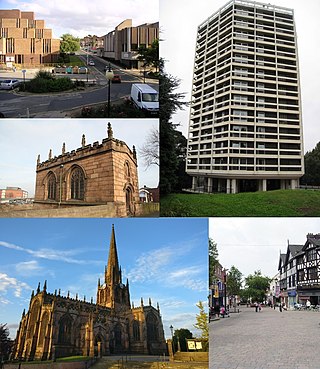
Concrete is a composite material composed of aggregate bonded together with a fluid cement that cures over time. Concrete is the second-most-used substance in the world after water, and is the most widely used building material. Its usage worldwide, ton for ton, is twice that of steel, wood, plastics, and aluminium combined.

Rust is an iron oxide, a usually reddish-brown oxide formed by the reaction of iron and oxygen in the catalytic presence of water or air moisture. Rust consists of hydrous iron(III) oxides (Fe2O3·nH2O) and iron(III) oxide-hydroxide (FeO(OH), Fe(OH)3), and is typically associated with the corrosion of refined iron.

Structural engineering is a sub-discipline of civil engineering in which structural engineers are trained to design the 'bones and joints' that create the form and shape of human-made structures. Structural engineers also must understand and calculate the stability, strength, rigidity and earthquake-susceptibility of built structures for buildings and nonbuilding structures. The structural designs are integrated with those of other designers such as architects and building services engineer and often supervise the construction of projects by contractors on site. They can also be involved in the design of machinery, medical equipment, and vehicles where structural integrity affects functioning and safety. See glossary of structural engineering.

A suspension bridge is a type of bridge in which the deck is hung below suspension cables on vertical suspenders. The first modern examples of this type of bridge were built in the early 1800s. Simple suspension bridges, which lack vertical suspenders, have a long history in many mountainous parts of the world.

Reinforced concrete, also called ferroconcrete, is a composite material in which concrete's relatively low tensile strength and ductility are compensated for by the inclusion of reinforcement having higher tensile strength or ductility. The reinforcement is usually, though not necessarily, steel bars (rebar) and is usually embedded passively in the concrete before the concrete sets. However, post-tensioning is also employed as a technique to reinforce the concrete. In terms of volume used annually, it is one of the most common engineering materials. In corrosion engineering terms, when designed correctly, the alkalinity of the concrete protects the steel rebar from corrosion.

Rebar, known when massed as reinforcing steel or reinforcement steel, is a steel bar used as a tension device in reinforced concrete and reinforced masonry structures to strengthen and aid the concrete under tension. Concrete is strong under compression, but has low tensile strength. Rebar significantly increases the tensile strength of the structure. Rebar's surface features a continuous series of ribs, lugs or indentations to promote a better bond with the concrete and reduce the risk of slippage.

Prestressed concrete is a form of concrete used in construction. It is substantially "prestressed" (compressed) during production, in a manner that strengthens it against tensile forces which will exist when in service.

A truss bridge is a bridge whose load-bearing superstructure is composed of a truss, a structure of connected elements, usually forming triangular units. The connected elements may be stressed from tension, compression, or sometimes both in response to dynamic loads. The basic types of truss bridges shown in this article have simple designs which could be easily analyzed by 19th and early 20th-century engineers. A truss bridge is economical to construct because it uses materials efficiently.

Glued laminated timber, commonly referred to as glulam, is a type of structural engineered wood product constituted by layers of dimensional lumber bonded together with durable, moisture-resistant structural adhesives so that all of the grain runs parallel to the longitudinal axis. In North America, the material providing the laminations is termed laminating stock or lamstock.

A concrete block, also known as a cinder block in North American English, breeze block in British English, concrete masonry unit (CMU), or by various other terms, is a standard-size rectangular block used in building construction. The use of blockwork allows structures to be built in the traditional masonry style with layers of staggered blocks.

A multistorey car park or parking garage, also called a multistory, parking building, parking structure, parkade, parking ramp, parking deck or indoor parking, is a building designed for car, motorcycle and bicycle parking and where there are a number of floors or levels on which parking takes place. The first known multistory facility was built in London in 1901, and the first underground parking was built in Barcelona in 1904. The term multistory is almost never used in the US, since parking structures are almost all multiple levels. Parking structures may be heated if they are enclosed.

The Clyde Arc is a road bridge spanning the River Clyde in Glasgow, Scotland, connecting Finnieston near the Clyde Auditorium and SEC with Pacific Quay and Glasgow Science Centre in Govan. Prominent features of the bridge are its innovative curved design, and that it crosses the river at an angle. The Arc is the first city centre traffic crossing over the river built since the Kingston Bridge was opened to traffic in 1970.

François Hennebique was a French engineer and self-educated builder who patented his pioneering reinforced-concrete construction system in 1892, integrating separate elements of construction, such as the column and the beam, into a single monolithic element. The Hennebique system was one of the first appearances of the modern reinforced-concrete method of construction.

Rotherham is a minster town in South Yorkshire, England. It is the largest settlement in the Metropolitan Borough of Rotherham. Rotherham is named after the River Rother, one of two major rivers to flow through the town.
The Bridgeport Lamp Chimney Company Bowstring Concrete Arch Bridge is located between Mechanic Street and Baltimore and Ohio Railroad tracks in Bridgeport, West Virginia. The bridge was constructed in 1924, designed by Frank McEnteer. This elegant bowstring reinforced concrete arch bridge represents a traditional bridge type which was readily adapted to what was essentially a new construction material: reinforced concrete. Unlike a rail or road bridge, this bridge can be considered an unusual pedestrian bridge in that it was built by the Bridgeport Lamp Chimney Company in 1924 to provide access from the glass plant to a warehouse on the other side of Simpson Creek. The bridge was designed to carry hand carts with glass products across the river to the warehouse. The bridge remains the only evidence of the original works, and its successor, Master Glass Company. Thus the bridge stands in splendid isolation from any other structure.

BCSA Ltd is a trade association for the structural steel industry in the UK and Ireland. It lobbies on behalf of its members, and provides them with education and technical services.
With multiple sites in the UK, Europe and a joint venture in India, Severfield plc is the market-leading structural steelwork Group in the UK and among the biggest in Europe, with a capacity to produce 250,000 tonnes of steelwork per year.

Julius Kahn was an American engineer, industrialist, and manufacturer. He was the inventor of the Kahn system, a reinforced concrete engineering technique for building construction. The Kahn system, which he patented in 1903, was used worldwide for housing, factories, offices and industrial buildings. He formed his own company, Trussed Concrete Steel Company, as a manufacturing source for his inventions. He also founded United Steel Company and was chairman of Truscon Laboratories.

The Florida International University pedestrian bridge collapse occurred on March 15, 2018, when a 175-foot-long section of the FIU-Sweetwater UniversityCity Pedestrian Bridge collapsed while under construction. The collapse resulted in six deaths, ten injuries, and eight vehicles being crushed underneath. Of the serious injuries, one employee was permanently disabled. At the time of the collapse, six lanes of road beneath the bridge were open to traffic.
The Fern Hollow Bridge is the name used for one of a series of three bridges in the East End of Pittsburgh, Pennsylvania, United States; each bridge carried Forbes Avenue over a large ravine in Frick Park. The first Fern Hollow Bridge opened in 1901 as a steel deck arch, and was demolished in 1972 while the second bridge was being built. The second bridge opened in 1973 and collapsed on January 28, 2022. Construction of the third bridge began on May 9, 2022, and the third bridge was dedicated on December 20, 2022.



















